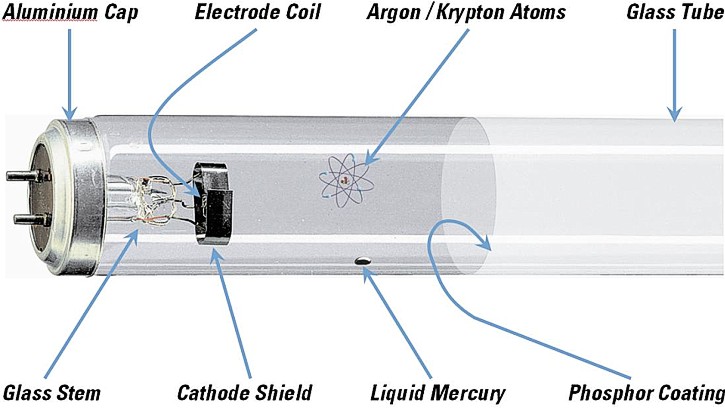|
|
|
|
|
Introduction
The convenience and popularity of the linear fluorescent lamp is underscored by the fact that it accounts for a greater amount of light produced on our planet than any other light source. It achieved this position of dominance by the 1970s and it is estimated that today it accounts for about 80% of the world's artificial light. It can be manufactured in almost any shade of white as well as coloured versions. It offers a low system cost, the lifetime is very long, it is fully dimmable and easy to use, and above all it achieves high luminous efficacies to yield a low cost of operation. The large area of the tube results in a low surface luminance, and it is especially well suited to the efficient and glare-free general illumination of large spaces. In 1980 its position was further strengthened by the introduction of the compact fluorescent lamp. Figure F1 illustrates the construction of a typical fluorescent tube.
|
 Figure F1 - Construction of the Fluorescent Lamp
Figure F1 - Construction of the Fluorescent Lamp |
Lamp Construction
The fluorescent tube is essentially a low pressure mercury discharge lamp. At either end of the tube is an electrode coil, also known as the cathode, whose purpose is to inject a flow of electrons into the discharge space. On account of its high operating temperature it is made from coiled tungsten wire, and is coated with various refractory oxides which increase its electron-emission efficiency. During life the electrode disintegrates and leads to blackening of the tube ends. To minimise the severity of blackening it is surrounded by a metallic shield. This shield also serves to reduce the visible 100Hz flicker which appears in the vicinity of the electrodes when operated at ordinary mains frequencies. The whole electrode assembly is mounted onto a glass stem assembly, the rim of which is fused to the end of the discharge tube to produce a sealed vessel. Via a narrow glass tube which pierces the stem, the lamp is dosed with a small quantity of mercury and filled to low pressure with an inert gas, typically argon or argon mixed with neon, krypton or xenon. In combination with the tube length and diameter, the choice of gas filling determines the lamp’s electrical properties. A phosphor coating is applied to the internal surface and a metal cap at either end provides the electrical and mechanical connection with the luminaire. The outer surface of the glass is often coated with an invisible silicone wax which breaks up films of moisture on lamps employed in humid environments. Although invisible, this feature is of paramount importance in ensuring reliable starting.
|
| Advantages |
Disadvantages |
| Very high luminous efficacy |
Contains toxic mercury vapour |
| Colour rendering is good to excellent |
Quite sensitive to ambient temperature |
| Low cost and simple control gear |
Light output drops in cold areas |
| Long lifetime, highly durable product |
Light output drops in hotter luminaires |
| Even and glare-free light distribution |
Flickering light on 50Hz magnetic ballasts |
| Can produce almost any shade of white |
Lumen output decreases through lifetime |
| Dimmable with special ballasts |
Very long tubes can be difficult to handle |
Applications
The physical dimensions of the fluorescent lamp play a certain role in defining its applications. Thanks to the large physical size, the surface luminance is low and it rarely gives rise to glare. The large source size also produces a highly uniform and shadow-free illumination. In conjunction with its long life and high efficacy, this makes it ideally suited to the general illumination of large interior spaces. Naturally the degree of optical control that can be attained from such a voluminous light source is limited, and this precludes it from accent and display lighting. Exterior applications are relatively scarce owing to its rather low luminous flux, and the fact that its luminous flux decreases sharply at low ambient temperatures.
|
Lamp History in Brief
The operating principle of the fluorescent lamp has very early origins, however its first practical form emerged in 1934 at the General Electric Company of England (Osram-GEC). It created the first hot cathode tubes employing a positive column discharge in a low pressure mercury atmosphere, to generate short-wavelength UVC radiation which stimulated a fluorescent powder coating on the inner surface of the discharge tube. This design lacked many of the features required to engineer it into a commercial product, and it is General Electric of USA who holds the title of being first to market a commercially viable fluorescent tube. Its 1938 development bears many similarities to the modern lamps, but during the past 80 years this lamp has undergone numerous changes in materials and design to ensure that it has always held its leading position as the lamp which offers the lowest total cost of ownership in producing a high quality white light.
|
|
|
|
|
|